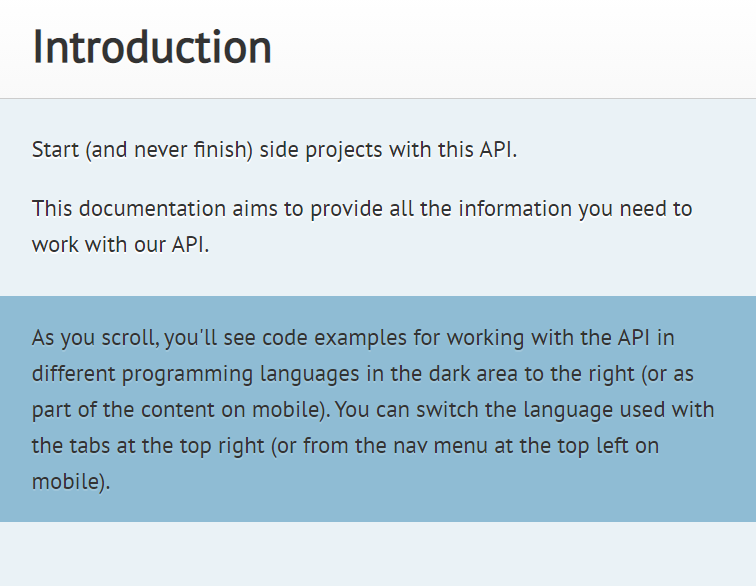General API info
You can add basics such as the title, introductory text, base URL and authentication information in your .scribe.config.js config file.
Title
To set the HTML <title> for the generated docs, use the title key. This title will also be used in the Postman collection and OpenAPI spec.
title: 'The SideProject API',
Description and introductory text
You can add a description of your API using the description key. This description will be displayed in the docs' "Introduction" section, and in the Postman collection and OpenAPI spec.
The introText key is where you'll set the text shown in the "Introduction" section of your docs (after the description).
You can also edit the .scribe/intro.md file that is added to your app after running generate.
Markdown and HTML are also supported (see HTML helpers)
description: 'Start (and never finish) side projects with this API.',
introText: `
This documentation will provide all the information you need to work with our API.
<aside>
As you scroll, you'll see code examples for working with the API in different programming languages in the dark area to the right (or as part of the content on mobile).
You can switch the language used with the tabs at the top right (or from the nav menu at the top left on mobile).
</aside>
`,

Base URL
You can set the base URL to be displayed in your docs (also known as the display URL) with the baseUrl key. For example, setting the baseUrl to this:
baseUrl: 'http://sideprojects.knuckles.wtf',
...means that http://sideprojects.knuckles.wtf will be shown in the generated docs, even if you ran the generate command on localhost or in CI.
You can also set the URL used in the API tester (Try It Out) and for response calls with the tryItOut.baseUrl and responseCalls.baseUrl keys.
Logo
Maybe you've got a pretty logo for your API or company, and you'd like to display that on your documentation page. No worries! To add a logo, set the logo key in .scribe.config.js to the path of the logo. Here are your options:
-
To point to an image on an external public URL, set
logoto that URL.logo: 'http://your-company/logo.png', -
To point to an image in your codebase, pass in the path to the image relative to your
outputPathdirectory (by default,public/docs).For example, if your logo is in
public/images:logo: '../img/logo.png', -
If you don't want a logo, set
logotofalse.
Authentication
You can add authentication information for your API using the auth section in .scribe.config.js.
You can also edit the .scribe/auth.md file that is added to your app after running generate.
Scribe uses the auth information you specify for four things:
- Generating an "Authentication" section in your docs
- Adding auth information to the Postman collection and OpenAPI spec
- Adding authentication parameters to your example requests for endpoints that use authentication
- Adding the necessary auth parameters with the specified value to response calls for endpoints that use authentication
Here's how you'd configure auth with a query parameter named apiKey:
module.exports = {
// ...
auth: {
enabled: true,
default: false,
in: 'query',
name: 'apiKey',
useValue: () => process.env.SCRIBE_API_KEY,
placeholder: 'YOUR-API-KEY',
extraInfo: 'You can retrieve your key by going to settings and clicking <b>Generate API key</b>.',
},
};
If apiKey were to be a body parameter, the config would be same. Just set in to 'body'.
Here's an example with a bearer token (also applies to basic auth, if you change in to 'basic'):
module.exports = {
// ...
auth: {
enabled: true,
default: false,
in: 'bearer',
name: 'hahaha', // <--- This value is ignored for bearer and basic auth
useValue: () => process.env.SCRIBE_AUTH_KEY,
placeholder: '{ACCESS_TOKEN}',
extraInfo: 'You can retrieve your token by visiting your dashboard and clicking <b>Generate API token</b>.',
},
};
And here's an example with a custom header:
module.exports = {
// ...
auth: {
enabled: true,
default: false,
in: 'header',
name: 'Api-Key', // <--- The name of the header
useValue: () => process.env.SCRIBE_AUTH_KEY,
placeholder: 'YOUR-API-KEY',
extraInfo: 'You can retrieve your token by visiting your dashboard and clicking <b>Generate API token</b>.',
},
};
The default field is the default behaviour of our API. If your endpoints are authenticated by default, set this to true, then use @unauthenticated on the method doc block if you need to turn off auth for specific endpoints. If your endpoints are open by default, leave this as false, then use @authenticated on the method doc block if you need to turn on auth for specific endpoints.
You can set whatever you want as the extraInfo. A good idea would be to tell your users where to get their auth key.
The useValue field is only used by Scribe for response calls. It won't be included in the generated output or examples. You can set it to a static value, or a function to be called to fetch that value
The placeholder is the opposite of useValue. It will be used only as a placeholder in the generated example requests.
For more information, see the reference documentation on the auth section.